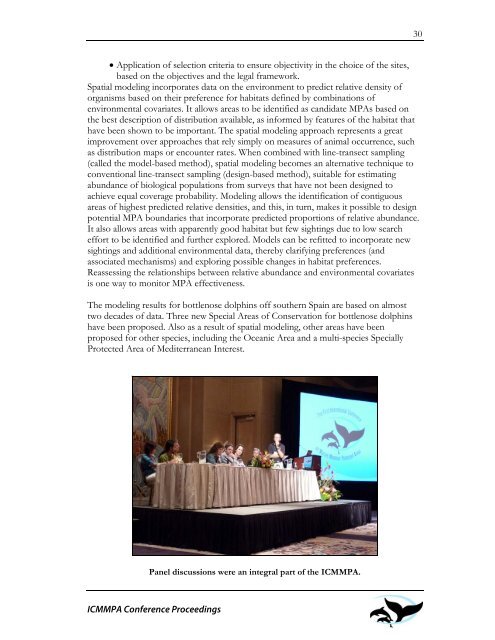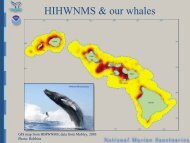The First International Conference on Marine Mammal Protected Areas
The First International Conference on Marine Mammal Protected Areas
The First International Conference on Marine Mammal Protected Areas
Create successful ePaper yourself
Turn your PDF publications into a flip-book with our unique Google optimized e-Paper software.
• Applicati<strong>on</strong> of selecti<strong>on</strong> criteria to ensure objectivity in the choice of the sites,<br />
based <strong>on</strong> the objectives and the legal framework.<br />
Spatial modeling incorporates data <strong>on</strong> the envir<strong>on</strong>ment to predict relative density of<br />
organisms based <strong>on</strong> their preference for habitats defined by combinati<strong>on</strong>s of<br />
envir<strong>on</strong>mental covariates. It allows areas to be identified as candidate MPAs based <strong>on</strong><br />
the best descripti<strong>on</strong> of distributi<strong>on</strong> available, as informed by features of the habitat that<br />
have been shown to be important. <str<strong>on</strong>g>The</str<strong>on</strong>g> spatial modeling approach represents a great<br />
improvement over approaches that rely simply <strong>on</strong> measures of animal occurrence, such<br />
as distributi<strong>on</strong> maps or encounter rates. When combined with line-transect sampling<br />
(called the model-based method), spatial modeling becomes an alternative technique to<br />
c<strong>on</strong>venti<strong>on</strong>al line-transect sampling (design-based method), suitable for estimating<br />
abundance of biological populati<strong>on</strong>s from surveys that have not been designed to<br />
achieve equal coverage probability. Modeling allows the identificati<strong>on</strong> of c<strong>on</strong>tiguous<br />
areas of highest predicted relative densities, and this, in turn, makes it possible to design<br />
potential MPA boundaries that incorporate predicted proporti<strong>on</strong>s of relative abundance.<br />
It also allows areas with apparently good habitat but few sightings due to low search<br />
effort to be identified and further explored. Models can be refitted to incorporate new<br />
sightings and additi<strong>on</strong>al envir<strong>on</strong>mental data, thereby clarifying preferences (and<br />
associated mechanisms) and exploring possible changes in habitat preferences.<br />
Reassessing the relati<strong>on</strong>ships between relative abundance and envir<strong>on</strong>mental covariates<br />
is <strong>on</strong>e way to m<strong>on</strong>itor MPA effectiveness.<br />
<str<strong>on</strong>g>The</str<strong>on</strong>g> modeling results for bottlenose dolphins off southern Spain are based <strong>on</strong> almost<br />
two decades of data. Three new Special <strong>Areas</strong> of C<strong>on</strong>servati<strong>on</strong> for bottlenose dolphins<br />
have been proposed. Also as a result of spatial modeling, other areas have been<br />
proposed for other species, including the Oceanic Area and a multi-species Specially<br />
<strong>Protected</strong> Area of Mediterranean Interest.<br />
Panel discussi<strong>on</strong>s were an integral part of the ICMMPA.<br />
ICMMPA <str<strong>on</strong>g>C<strong>on</strong>ference</str<strong>on</strong>g> Proceedings<br />
30



